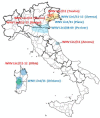The complex epidemiological scenario of West Nile virus in Italy
- PMID: 24084676
- PMCID: PMC3823324
- DOI: 10.3390/ijerph10104669
The complex epidemiological scenario of West Nile virus in Italy
Abstract
Entomological, veterinary, and human surveillance systems for West Nile virus (WNV) infection have been implemented in Italy since the first detection of the virus in 1998. These surveillance activities documented a progressive increase of WNV activity and spread in different regions and the emergence of new WNV lineages and strains. Italy is a paradigmatic example of the complex epidemiology of WNV in Europe, where sporadic cases of WNV infection, clusters, and small outbreaks have been reported in several regions. In addition, different strains of both WNV lineage 1 and lineage 2 have been identified, even co-circulating in the same area.
Figures



References
-
- Sambri V., Capobianchi M., Charrel R., Fyodorova M., Gaibani P., Gould E., Niedrig M., Papa A., Pierro A., Rossini G., Varani S., Vocale C., Landini M.P. West Nile virus in Europe: Emergence, epidemiology, diagnosis, treatment, and prevention. Clin. Microbiol. Infect. 2013;19:699–704. doi: 10.1111/1469-0691.12211. - DOI - PubMed
-
- Rizzo C., Salcuni P., Nicoletti L., Ciufolini M.G., Russo F., Masala R., Frongia O., Finarelli A.C., Gramegna M., Gallo L., et al. Epidemiological surveillance of West Nile neuroinvasive diseases in Italy, 2008 to 2011. [(accessed on 22 September 2013)];Euro surveill. 2012 17 Available online: http://www.eurosurveillance.org/ViewArticle.aspx?ArticleId=20172. - PubMed
Publication types
MeSH terms
LinkOut - more resources
Full Text Sources
Other Literature Sources
Medical

